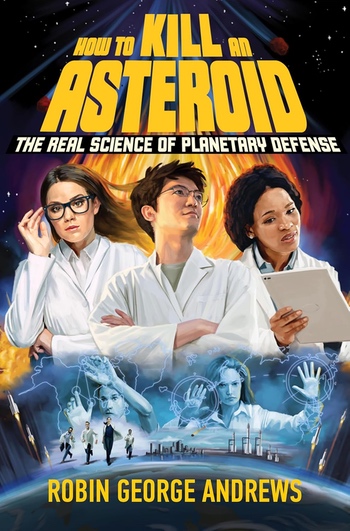Review: How to Kill an Asteroidby Jeff Foust
|
| “It seems patently absurd that such a nothingburger of an asteroid almost killed people,” he writes of the Chelyabinsk meteor. |
DART is the heart of How to Kill an Asteroid by science writer Robin George Andrews. The book examines the science of near Earth asteroids, the threats they pose, and how they could be addressed with concepts ranging from kinetic impactors to nuclear weapons to more exotic concepts like “gravity tractor” spacecraft. Threaded through that discussion is the development, launch, and operation of DART through its impact.
Andrews provides an extensive, enlightening review of the history and state of planetary defense, talking to many of the major people involved in the field today. They have colorful stories to tell, such as one scientist who was investigating a potential impact crater in the Congo only to be arrested and jailed, requiring diplomatic assistance to be released. Fortunately, defending the planet usually does not put people at that level of risk.
A theme of the book is that for all the progress made in planetary defense, like the success of DART, it’s not nearly enough. An example of that, Andrews argues, is NEO Surveyor, the space telescope that will be the successor to NEOWISE, designed specifically to find near Earth objects and meet congressional goals of nearly all objects at least 140 meters across. Yet the mission struggled for years to win funding through the Discovery program of planetary science missions, only getting approved in 2019 when NASA directed development of the mission. Even then the mission suffered a funding setback in 2023 when NASA requested only a fraction of the projected funding. Why? No one seemed to know, other than the agency simply ran short of money during its budget development and NEO Surveyor was the unlucky mission to fill the gap.
How to Kill an Asteroid can be entertaining at times, written in a casual, accessible style (“It seems patently absurd that such a nothingburger of an asteroid almost killed people,” he writes of the Chelyabinsk meteor.) One flaw is that approach can go off on tangents that go a little too far out on a limb: the discussion of NEO Surveyor leads to mentioning the Vera Rubin Observatory, a groundbased telescope that could also become a key tool for spotting asteroids. That is followed by concerns that megaconstellations can interfere with astronomy, leading to the conclusion that Starlink “does make us less safe as a species,” as one astronomer puts it. There’s little discussion in that section about the cooperation between astronomers and companies to mitigate the brightness of satellites, or whether Starlink is the worst offender versus other constellations, or how much of an impact constellations will have on the ability to detect near Earth objects (a NASA scientist, speaking at an advisory committee meeting early this year, played down concerns about megaconstellations interfering with such discoveries.)
The book is effective in explaining both the threats of asteroid impacts and the ability of humanity to do something about them, a capability we lack for many other natural disasters. It argues that we could be doing more, but the same is true for many other challenges we face: is a dollar more spent on planetary defense better than a dollar more spent on, say, improved weather forecasting? The book doesn’t attempt that calculus, but does make clear that it is within our means to protect ourselves from this threat.
Note: we are now moderating comments. There will be a delay in posting comments and no guarantee that all submitted comments will be posted.
